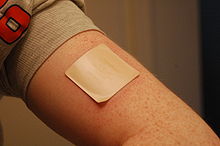
Back معالجة النيكوتين بالإعاضة Arabic নিকোটিন প্রতিস্থাপন থেরাপি Bengali/Bangla Teràpia de substitució de nicotina Catalan Therapi amnewid nicotin Welsh Nikotinersatztherapie German Υποκατάστατα νικοτίνης Greek Terapias de reemplazo de nicotina Spanish درمان جایگزینی نیکوتین Persian Substitut nicotinique French טיפולי החלפת ניקוטין HE
 A nicotine patch is applied to the left arm. | |
| Clinical data | |
|---|---|
| Trade names | Nicoderm, Commit, Nicorette, others[1] |
| Other names | NRT |
| AHFS/Drugs.com | Monograph |
| MedlinePlus | a601084 |
| License data | |
| Routes of administration | Oral, Inhalation, Transdermal, |
| ATC code | |
| Legal status | |
| Legal status | |
| Pharmacokinetic data | |
| Metabolites | Cotinine |
| Excretion | renal |
| Identifiers | |
| |
| CAS Number | |
| PubChem CID | |
| ChemSpider | |
| UNII | |
| Chemical and physical data | |
| Formula | C10H14N2 |
| Molar mass | 162.236 g·mol−1 |
Nicotine replacement therapy (NRT) is a medically approved way to treat people with tobacco use disorder by taking nicotine through means other than tobacco.[6] It is used to help with quitting smoking or stopping chewing tobacco.[1][7] It increases the chance of quitting tobacco smoking by about 55%.[8] Often it is used along with other behavioral techniques.[1] NRT has also been used to treat ulcerative colitis.[1] Types of NRT include the adhesive patch, chewing gum, lozenges, nose spray, and inhaler.[1] The use of multiple types of NRT at a time may increase effectiveness.[9][10]
Common side effects depend on the formulation of nicotine.[1] Common side effects with the gum include nausea, hiccups, and irritation of the mouth.[1] Common side effects with the patch include skin irritation and a dry mouth while the inhaler commonly results in a cough, runny nose, or headaches.[1] Serious risks include nicotine poisoning and continued addiction.[1] They do not appear to increase the risk of heart attacks.[8] There are possible harms to the baby if used during pregnancy.[1][11] Nicotine replacement therapy works by reducing cravings caused by nicotine addiction.[1][12]
They were first approved for use in 1984, in the United States.[1] Nicotine replacement products are on the World Health Organization's List of Essential Medicines.[13][14][15] They are available as generic medications.[1]
- ^ a b c d e f g h i j k l m "Nicotine". The American Society of Health-System Pharmacists. Archived from the original on 18 December 2015.
- ^ "Nicoderm CQ- nicotine patch, extended release". DailyMed. Retrieved 26 January 2022.
- ^ "Commit - nicotine lozenge". DailyMed. Retrieved 26 January 2022.
- ^ "Nicorette- nicotine polacrilex lozenge". DailyMed. Retrieved 26 January 2022.
- ^ "Nicorette White Ice Mint- nicotine polacrilex gum, chewing Nicorette Original- nicotine polacrilex gum, chewing Nicorette Cinnamon Surge- nicotine polacrilex gum, chewing Nicorette Fresh Mint- nicotine polacrilex gum, chewing Nicorette Mint- nicotine polacrilex gum, chewing Nicorette Spearmint Burst- nicotine polacrilex gum, chewing". DailyMed. Retrieved 26 January 2022.
- ^ Jain R, Majumder P, Gupta T (2013). "Pharmacological intervention of nicotine dependence". BioMed Research International. 2013: 278392. doi:10.1155/2013/278392. PMC 3891736. PMID 24490153.
- ^ Smith KD, Scott MA, Ketterman E, Smith PO (April 2005). "Clinical inquiries. What interventions can help patients stop using chewing tobacco?". The Journal of Family Practice. 54 (4): 368–9. PMID 15833231.
- ^ a b Hartmann-Boyce J, Chepkin SC, Ye W, Bullen C, Lancaster T, et al. (Cochrane Tobacco Addiction Group) (May 2018). "Nicotine replacement therapy versus control for smoking cessation". The Cochrane Database of Systematic Reviews. 5 (5): CD000146. doi:10.1002/14651858.CD000146.pub5. PMC 6353172. PMID 29852054.
- ^ McDonough M (August 2015). "Update on medicines for smoking cessation". Australian Prescriber. 38 (4): 106–11. doi:10.18773/austprescr.2015.038. PMC 4653977. PMID 26648633.
Evidence suggests that combinations of nicotine replacement therapy may be more effective than using a single formulation
- ^ Cahill K, Stevens S, Perera R, Lancaster T (May 2013). "Pharmacological interventions for smoking cessation: an overview and network meta-analysis". The Cochrane Database of Systematic Reviews. 5 (5): CD009329. doi:10.1002/14651858.CD009329.pub2. PMC 8406789. PMID 23728690. S2CID 205199430.
Combination NRT also outperformed single formulations
- ^ De Long NE, Barra NG, Hardy DB, Holloway AC (December 2014). "Is it safe to use smoking cessation therapeutics during pregnancy?". Expert Opinion on Drug Safety. 13 (12): 1721–31. doi:10.1517/14740338.2014.973846. PMID 25330815. S2CID 207488115.
- ^ Nicotine Replacement Therapy for Smoking Cessation or Reduction: A Review of the Clinical Evidence (Report). Canadian Agency for Drugs and Technologies in Health. 16 January 2014. PMID 24741730.
- ^ World Health Organization (2019). World Health Organization model list of essential medicines: 21st list 2019. Geneva: World Health Organization. hdl:10665/325771. WHO/MVP/EMP/IAU/2019.06. License: CC BY-NC-SA 3.0 IGO.
- ^ World Health Organization (2021). World Health Organization model list of essential medicines: 22nd list (2021). Geneva: World Health Organization. hdl:10665/345533. WHO/MHP/HPS/EML/2021.02.
- ^ "Nicotine Replacement Therapy (NRT) (Inclusion)". World Health Organization. 11 December 2010. Archived from the original on February 13, 2010. Retrieved 28 May 2020.
© MMXXIII Rich X Search. We shall prevail. All rights reserved. Rich X Search